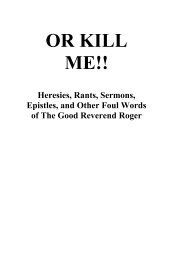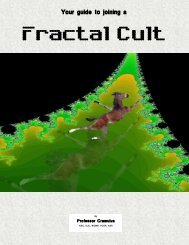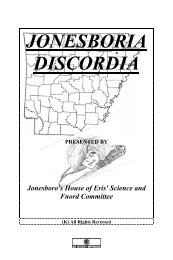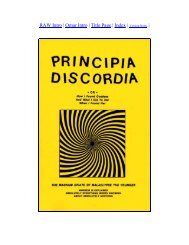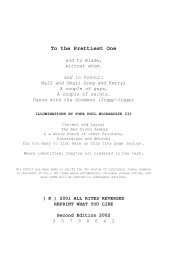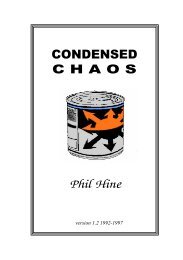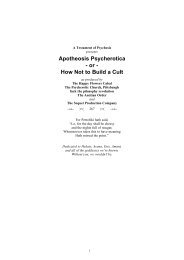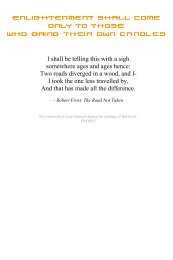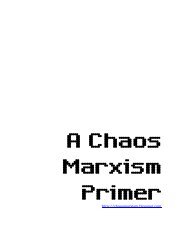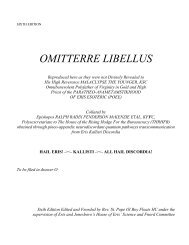Coincidance - Principia Discordia
Coincidance - Principia Discordia
Coincidance - Principia Discordia
Create successful ePaper yourself
Turn your PDF publications into a flip-book with our unique Google optimized e-Paper software.
COINCIDANCE 153<br />
principle) Jung and Pauli called synchronicity because they assumed it was at<br />
tight angles to causality and structured in space, not time. That is, the<br />
synchronicities (from the Greek, syn, together, and chronos, time) happen at<br />
the same time.<br />
The relation between synchronous events, according to Jung, is basically<br />
psychological. The logic, in other words, is the logic of the deep psyche,<br />
which Jung (and Freud) had found in dreams and myths.<br />
Barbara Honegger, a leading student of these matters, has pointed out a<br />
basic defect in the Jung-Pauli theory. ACOPs are by no means only<br />
synchronous. They are often separated by days or even years.<br />
A new light was shed on ACOPs in 1964 by the Scots physicist John Bell.<br />
Bell's theorem holds that if quantum physics is accurate, particles that were<br />
once in contact continue to influence one another, no matter how far apart<br />
they move. This influence is instantaneous, according to Bell, even if the<br />
particles are at opposite ends of the Universe.<br />
This makes a nasty problem for physicists because Bell's conclusion<br />
directly contradicts Einstein's special relativity, which holds that any<br />
influence between particles must require an energy transfer, and energy<br />
cannot move instantaneously. Energy only moves at the speed of light or<br />
less. Bell's theorem provides a possible mechanism at the quantum level for<br />
the acausal interaction of apparently unrelated events. Whether it can be<br />
applied beyond the strange world of subatomic particles is a question so far<br />
without a firm answer.<br />
Four experiments have confirmed Bell's math; two have cast doubt on it;<br />
research is continuing. Meanwhile, some physicists have started reflecting<br />
on how to reconcile Bell with Einstein, if both are right. Dr. Evan Harris<br />
Walker has suggested that the "influence" in the Bell connection does not<br />
involve energy and hence does not contradict Einstein. The influence,<br />
Walker proposes, is consciousness itself.<br />
Dr. lack Sarfat ti offers a different interpretation. The medium of the Bell<br />
interconnectedness, he says, is not consciousness but information. Now,<br />
information is very abstract in communication theory: it is the negative<br />
reciprocal of entropy, which means roughly that it is the opposite of<br />
disorder, it is almost what we call system or organization in daily speech.<br />
Information, Sarfatti proposes, is not bound by the same laws as energy and<br />
not subject to Einsteinian limits.<br />
This would explain a great many of the ACOPs collected by Jung,<br />
Kammerer, Koestler and others; it might even explain the Hardy-Harvie<br />
experiment, in which randomizing led to more order rather than more<br />
disorder. And it throws all of the data of parapsychology into a new<br />
Perspective: instead of separate paranormal abilities such as ESP, precognition



